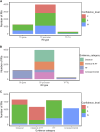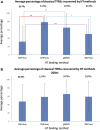Flexible gold standards for transcription factor regulatory interactions in Escherichia coli K-12: architecture of evidence types
- PMID: 38505828
- PMCID: PMC10949920
- DOI: 10.3389/fgene.2024.1353553
Flexible gold standards for transcription factor regulatory interactions in Escherichia coli K-12: architecture of evidence types
Abstract
Post-genomic implementations have expanded the experimental strategies to identify elements involved in the regulation of transcription initiation. Here, we present for the first time a detailed analysis of the sources of knowledge supporting the collection of transcriptional regulatory interactions (RIs) of Escherichia coli K-12. An RI groups the transcription factor, its effect (positive or negative) and the regulated target, a promoter, a gene or transcription unit. We improved the evidence codes so that specific methods are incorporated and classified into independent groups. On this basis we updated the computation of confidence levels, weak, strong, or confirmed, for the collection of RIs. These updates enabled us to map the RI set to the current collection of HT TF-binding datasets from ChIP-seq, ChIP-exo, gSELEX and DAP-seq in RegulonDB, enriching in this way the evidence of close to one-quarter (1329) of RIs from the current total 5446 RIs. Based on the new computational capabilities of our improved annotation of evidence sources, we can now analyze the internal architecture of evidence, their categories (experimental, classical, HT, computational), and confidence levels. This is how we know that the joint contribution of HT and computational methods increase the overall fraction of reliable RIs (the sum of confirmed and strong evidence) from 49% to 71%. Thus, the current collection has 3912 reliable RIs, with 2718 or 70% of them with classical evidence which can be used to benchmark novel HT methods. Users can selectively exclude the method they want to benchmark, or keep for instance only the confirmed interactions. The recovery of regulatory sites in RegulonDB by the different HT methods ranges between 33% by ChIP-exo to 76% by ChIP-seq although as discussed, many potential confounding factors limit their interpretation. The collection of improvements reported here provides a solid foundation to incorporate new methods and data, and to further integrate the diverse sources of knowledge of the different components of the transcriptional regulatory network. There is no other genomic database that offers this comprehensive high-quality architecture of knowledge supporting a corpus of transcriptional regulatory interactions.
Keywords: E. coli; RegulonDB; confidence levels; evidence codes; high-throughput genomic methodologies; regulatory interactions; source of knowledge.
Copyright © 2024 Lara, Gama-Castro, Salgado, Rioualen, Tierrafría, Muñiz-Rascado, Bonavides-Martínez and Collado-Vides.
Conflict of interest statement
The authors declare that the research was conducted in the absence of any commercial or financial relationships that could be construed as a potential conflict of interest.
Figures






Update of
-
A Gold Standard for Transcription Factor Regulatory Interactions in Escherichia coli K-12: Architecture of Evidence Types.bioRxiv [Preprint]. 2023 Dec 11:2023.02.25.530038. doi: 10.1101/2023.02.25.530038. bioRxiv. 2023. Update in: Front Genet. 2024 Mar 05;15:1353553. doi: 10.3389/fgene.2024.1353553. PMID: 37163020 Free PMC article. Updated. Preprint.
References
Grants and funding
LinkOut - more resources
Full Text Sources
Miscellaneous

